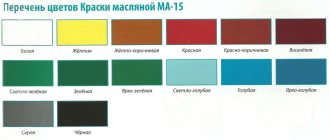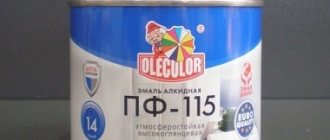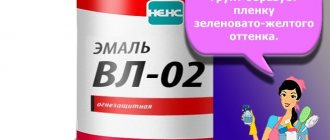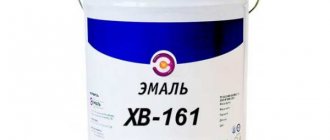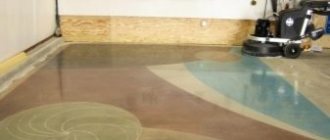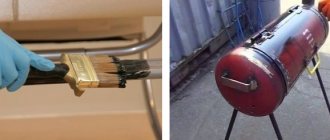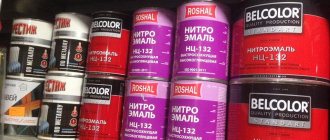Composition and features
AK-511 paint is an enamel based on an acrylic copolymer, which is combined with modifying additives. The latter include solid particles of color (pigment). Along with this enamel there are xyol and toluene, which act as solvents.
Among the features of the paint are the following:
- remains visible to drivers when the road is illuminated at night;
- dries within half an hour;
- adheres well to surfaces (asphalt, concrete, etc.);
- good wear resistance;
- maintains integrity during temperature changes.
The enamel contains special glass beads that provide road markings with reflective properties. Moreover, after drying, the paint forms a semi-matte, uniform film on the asphalt.
Expert opinion
Zakharova Irina Yurievna
Cleaning professional with 15 years of experience. Our best expert.
Ask a Question
Basically, enamel is produced in white. Yellow, red and orange shades are also available, which have a limited area of application. In addition, this material is also available in black, used to paint over old markings.
If necessary, during production the composition is mixed with other pigments, which make it possible to obtain the desired shades. This material imposes strict requirements for storage and transportation. In particular, it is important to maintain the temperature regime and the specified humidity level.
Purpose of paint
Road marking enamel AK-511 is produced in accordance with GOST R 52575-2006 and is used for drawing safety lines on public roads. The enamel is designed for those routes where there is intense and moderate traffic, it is excellent for the following coatings:
- cement concrete;
- asphalt concrete.
Horizontal road markings made using paint are also widely used in areas near warehouses, parking lots, parking lots, and airfields. The black material is used not for marking roads, but for demarcating old markings (painting them over). To provide the marking with reflective properties, additives are introduced into the enamel - special glass beads. According to GOST, it is permissible to apply the product on the roadway of categories 1–4.
Specifications
The characteristics of this material are given in the table.
See also
Rules for choosing engine paint and instructions for applying it yourself
| Average consumption (one layer, g/m2) | 300-400 |
| Features of road markings after the enamel has dried | Smooth, without inclusions, shiny |
| Material viscosity degree | 80-160 s |
| Amount of dry residue (from the total volume of enamel) | 75,00 % |
| Adhesion level | 1 b |
| Complete drying time (at a temperature of +20 degrees) | 30 minutes |
| Brightness level | 70,00 % |
| Resistance to external influence (in minutes) | Gasoline - 20; water - 72; 3% aqueous sodium chloride solution – 72 |
| Density (g/m2) | 1,4 |
| Abrasion resistance (g/µm) | 600 |
General requirements
Why should road markings light up?
Not all road routes are marked with luminous markings, and now they can be found on autobahns, as well as on highways with incredibly heavy traffic.
Glowing paint helps to reflect light from car headlights and also helps prevent traffic accidents.- Thanks to the markings, the driver will be able to navigate the road much better at night and during the day.
- Paint with light reflective properties helps to recognize permitting and prohibiting signs at dusk or late at night.
And now a little about what requirements are imposed on paints for roads.
Requirements for road type paints
Marking can be applied only in the warm season, and it must comply with GOST R51256.
Road paints and varnishes for marking on asphalt must not only reflect light, but also have other technical characteristics:
- The paint must be quick-drying, and often the necessary compositions have time to harden after only 5 minutes when applied at a temperature of +20 degrees.
- The consumption of paint and varnish composition should be small.
- Moisture resistant.
- Resistant to temperature changes.
- High resistance to wear and mechanical damage.
- The composition must be conveniently applied, and most often this is done using a spray gun and a stencil laid on the asphalt. Thanks to this technology, application occurs quite quickly, as well as with minimal consumption of paint with light reflecting properties.
- In no case should the paint interfere with the quality of adhesion of the car tire to the roadway.
The coloring composition must be bright in color so that at night, in bad weather conditions, the markings are visible even to the naked eye.
Advantages and disadvantages
AK-511 enamel is characterized by the following advantages:
- resistance to mechanical stress, contact with gasoline, fuels and other aggressive substances;
- high level of brightness (remains visible regardless of weather conditions for 24 hours after application);
- resistance to washing off;
- resistance to temperature changes;
- characteristics do not change when exposed to ultraviolet radiation;
- fast drying speed.
The characteristics of the material (wear resistance, and so on) directly depend on the type of additional components that are added to the initial composition (sand, reagents, and others). To apply this enamel, specialized equipment is required.
Application methods
The product can be applied with a roller, brush, or spray. The distance from the spray nozzle to the surface is 20–30 cm. The operating mode is selected depending on the brand of the device. Usually 1-2 layers of paint are enough. Consumption is 400–600 g/sq.m. m. Glass beads are mixed into the paint at the rate of 300 g/sq. m of coverage.
Application to wet road surfaces is not allowed, and the material must not be diluted with water, gasoline, or kerosene. Wash equipment with toluene. Drivers will be able to use the road 15–30 minutes after applying the enamel, depending on the air temperature (the higher it is, the faster the coating dries).
Terms of use
AK-511 paint can be used at temperatures from +5 to +30 degrees and humidity not exceeding 80%. Applying the composition is allowed on a previously prepared surface. To do this, the asphalt is cleaned of sand, dirt, oil and grease, and then dried.
Before application, the paint is checked for viscosity. If this indicator is too high, then solvents are added to the initial composition (R-5A is more often used). If necessary, the enamel is mixed with quartz sand with a grain size of three millimeters, which improves the wear resistance of road markings. In this case, the concentration of this component should not exceed 10% of the enamel volume.
See also
Technical characteristics of water-based paint VEAK-1180 and top 6 companies
An airless sprayer is used to apply the paint. The device must be kept at a distance of 20-30 centimeters from the road surface. Typically the paint is applied in 1 or 2 layers. The material consumption for this use is 400-600 grams per square meter.
In some cases, brushes or rollers are used instead of this equipment. Also, if necessary, paint is applied with a hand sprayer. But in each of the above cases it is more difficult to create even and long markings. If it is necessary to improve the reflective properties of road markings, then after applying the paint a layer of special granules is laid on top for 10 seconds. The latter reduce material consumption by 2 times.
Subject to the above rules, road markings retain all operational characteristics. Otherwise, the indicators of marking resistance to environmental influences are reduced. The passage for vehicles is opened 20-30 minutes after the markings are applied.
Preparing for work
You should work with enamel only in dry weather. The coating is cleaned as much as possible from dirt and dust. Air temperature +5...+30 degrees, air humidity does not exceed 85%.
Before application, mix the paint well until the sediment completely disappears. To eliminate bubbles after mixing, leave the material for another 10 minutes. Various solvents can be used for dilution. How to dilute is indicated in the instructions for use - you can use toluene, P-4, acetone, ethyl acetate, butyl acetate. The amount of solvent from the total mass of the material does not exceed 15%. If there is a break in work, the product must be tightly closed and stirred again before work.
Precautionary measures
AK-511 paint is a toxic material classified as hazard class three. This is explained by the fact that before use, the enamel is mixed with solvents, which quickly evaporate into the air.
Therefore, when working with this composition, it is necessary to wear a respirator, gloves and goggles.
It is prohibited to apply paint near open sources of fire. This is also due to the presence of flammable solvents in the enamel. If the material catches fire, the fire area should be extinguished with sand, water, foam or asbestos.
Storage and Security
The shelf life of the product is 6 months. It should be stored in a tightly sealed container, protected from water and direct sunlight. Storage temperature – within –30…+40 degrees.
Security measures are as follows:
- the paint is toxic due to the presence of solvents in the composition, hazard class – 3, maximum permissible concentration in the air of the working area – up to 150/50 mg/cu. m,
- workers must wear gloves or apply protective pastes to the skin of their hands,
- Respiratory organs must be protected with respirators or gas masks,
- fire safety measures must be strictly observed - no smoking, no sparks,
- In case of fire, extinguish with sand, asbestos blankets, foam, water.
The material is produced by Khimprom-M LLC. You can also find paint from . The enamel is produced in containers of 20, 27, 55 liters.
Analogs
The main analogue of AK-511 enamel is AK-505 paint. Both compositions differ in the degree of coverage, viscosity level and a number of other characteristics. You can also replace the AK-511 with:
- enamel “Line” (used on roads with heavy traffic);
- acrylic paint “Virage”;
- acrylic enamel "Liniya-M";
- "Liniya-Aero" (used at airfields);
- fluorescent enamel AK-5173.
The above information shows that AK-511 paint is a versatile material used for various purposes. Analogs of this composition have a more limited scope of application.
See also
Suitable paints for countertops and how to apply them yourself
Properties of enamel AK-511
AK-511 enamel is intended for marking roadways with improved surfaces (asphalt, asphalt concrete, cement concrete). The characteristics of the enamel allow it to be used on roads with medium and high traffic intensity in the widest range of climatic zones at temperatures from minus 40°C to plus 60°C.
Enamel of different colors has identical properties; black enamel is intended for demarcating temporary road markings.
The drying time of the enamel ranges from 15 to 30 minutes and depends on the ambient temperature and the temperature of the road surface. The fast drying time allows the enamel to be used even on heavily loaded roads without a significant and long-term loss of throughput.
Features of choosing enamel
The composition of the paint and varnish material for marking will help determine the conditions for its use:
- Regional climatic conditions.
- Intensity of traffic – on highways, markings require materials that are resistant to wear. Two-component compositions are perfect here.
- Physico-chemical features of asphalt-type coatings.
Let's take a closer look
Acrylic
Acrylic type paint is available in a concentrated state and therefore should be diluted with water to the required level of thickness. It is easy to use and can also be sold ready-made, as an aerosol. Acrylic-based paint can be applied using any method, but the most commonly used method is aerosol application. Such compositions can be applied not just to asphalt, but also to oil-bitumen and road concrete pavements. You should work with water-dispersion-type compounds in dry and warm weather, because if they get wet, they can be washed off the road surface immediately after application. The polyacrylic mixture hardens within ½ hour after painting.
Alkyd
AK-511 paint is not alkyd, but alkyd-type dyes have a rubber base. They appeared quite recently. In addition, they have high adhesive properties and increased wear resistance. Such paints performed well on high-speed highways. Consumption per square meter may vary for different types of coatings. This type of paint cannot be applied using an aerosol method. Other paints and varnishes, to which reflective powder is added, can be used for low-traffic routes and in places where road markings have already been drawn. Use on a busy highway is not recommended because the distribution of illuminating particles in them will be uneven.
Two-component
Such enamels are innovative. Their production is carried out using the most modern technologies. The composition contains no solvents, and the concentration of reflective pigments is much higher than that of other compositions. Such paint and varnish compositions have high strength and excellent adhesive characteristics. The applied markings will not be damaged even by snow removal equipment, and two-component enamels can be used for any type of coating. To apply them, you can use both classic aerosols and complex special drawing techniques. The mixture consumption will not be more than 0.5 kg per square meter. You can also apply airfield markings.
Application technology
Road markings are applied in two ways, and their choice will depend on the physical state of the paint that will be applied.
- Cold state. This application technology is used when working with dyes or enamels based on natural solvents, cold plastics, as well as water-dispersed coloring compositions. In this way, markings are applied to areas with high surface wear, for example, at pedestrian crossings. The shelf life of the marking is approximately 2 years. When there is a heavy traffic load, the hot method of applying paint is used.
- Thermoplastics and yellow-type thermoplastic tapes should be applied using the hot method and adhered to the road surface with a gas torch. Work should be carried out at an ambient temperature of +5 to +36 degrees.
Next, we propose to consider a certain composition.
Composition of road coatings AK-511
Among dyes, narrow-profile applications of materials can be distinguished. These include paint such as AK-511. It is applied to an asphalt road, and hence the name - road. It should be applied on highways, at the training ground where driving training for drivers is carried out, and also on the airfield runway. The frequency of marking updates will depend on the intensity of traffic on the road. Clearly visible white stripes are the result of adhesion of the material to the road surface (concrete and asphalt). Reflective beads are sometimes added to road paint. It is designed for use in temperate continental climate latitudes.
This is road-type paint that is used to mark streets and roadways. It is used in temperate continental climate conditions. The dye contains pigments and fillers, which are combined with modifying additives. This composition complies with GOST R52575-2006, which will regulate the use of general purpose road surfaces for painting. This is a fast-drying mixture that has excellent light resistance and an increased brightness coefficient. The markings will be visible in any type of lighting. Like other paints, AK-511 has excellent adhesive properties, high resistance to wear, as well as to chemical and humid environments. To enhance the reflective result, glass beads can be added to the enamel to return light. It should be applied to a dry and cleaned surface, and thinner can be added to the enamel. To further increase the reflectivity of the markings, it is worth applying a paint coating over the markings.
This technology has many advantages:
The coating will comply with GOST.- The marking is much more resistant to external influences.
- Fast application method.
- The functional qualities of road markings are improved.
With a layer thickness of 0.25 cm, each square meter will require 3.5 to 4 kg of paint. On the road surface, the dried layer of paint becomes a uniform, shiny film. Markings can be yellow, white, red, black and orange. The color will directly depend on the purpose. Manufacturers produce paint in 25-liter buckets and containers, and consistent storage conditions dictated by the manufacturer + proper transportation will ensure that the paint meets all standards. When transporting paint containers, depressurization must not be allowed, the storage temperature regime must not be violated, and the humidity level must not deviate from the norms.
Application conditions
Paint for road markings is applied at temperatures from +5..+36 degrees, and at air humidity less than 80%. Before application, the road surface is prepared. It should be dried, cleaned of dirt, sand and oil/grease stains. The paint should be checked for viscosity and stirred thoroughly. If the material has a thick consistency, then solvent R-5A can be used. an additive in the form of quartz sand with grains of 0.03 cm increases the resistance of the dye to wear. In this case, the proportion of additives from the paint mass should be no more than 10%. Markings must be applied using special equipment - an airless sprayer. Hand sprayers, brushes and rollers are also used.
Reflective granules will increase the light reflection characteristics of the coating. They should be applied after a maximum of 10 seconds over the enamel. If the markings on the road surface are applied in accordance with the instructions, then all the performance indicators that the manufacturer will proclaim will be guaranteed. But if the conditions are violated, the period of use of the dye is reduced. For example, you cannot apply markings on roads in conditions of high humidity or on wet road surfaces.
